金融英语lecture1money
- 格式:doc
- 大小:35.50 KB
- 文档页数:9
![[教材]高等院校金融英语教科书第一单元翻译](https://uimg.taocdn.com/39ee830453d380eb6294dd88d0d233d4b14e3fca.webp)
货币(Money)1,1货币的定义:货币是指在支付购买商品和服务的款项方面以及在清偿债务方面为人们所普遍接受的事物。
currency(指纸币和硬币)显然符合这一定义,是money的一种类型。
然而,money仅仅是被定义为currency对于现在的人们来说太狭隘了,因为事实上不仅可以通过currency(货币,指硬币和纸币)进行支付,还可以通过支票转账和电子转账来进行支付。
因此,支票也作为被接受的用于购买的支付工具,支票账户存款也被认为是种货币。
有时,就有必要使用货币(money)的广义定义,因为如果money可以很便捷的转换为currency,那么像储蓄存款等实际上也可以发挥货币的作用。
1.2货币的类型1.2.1商品货币:商品货币或者实物货币是一种其价值来源于制作商品的货币,制作商品货币或实物货币的商品本身也拥有价值同时也可作为货币来使用。
曾被用来作为交换媒介的商品有金、银、铜、盐、大的石头、装饰的腰带、贝壳、酒、烟、大麦等。
实际上,在过去的4000年期间,主要的商品货币是贵金属:大多数是银、金,也称为足值货币,贵金属货币阶段是商品货币的阶段之一。
几乎所有的国家都曾经经历过贵金属货币(是货币的一种完美的形式)阶段。
1.2.2代用货币:代用货币或者代用足值货币是指完全有贵金属作为支持的货币。
代用货币的价值与商品有着直接固定的关系,然而它们本身并不是由商品构成。
在20世纪30年代,经济与金融危机爆发,纸币不再能兑换为贵金属,金本位制或者银本位制瓦解,主要的西方国家不得不脱离金属本位制。
因此,纸币不能再被兑换为黄金。
自那时开始,代用货币退出流通领域,信用货币就出现了。
1.2.3信用货币:信用货币既不是由特定的有价值的商品构成的也不代表特定的有价值的商品。
信用货币的价值取决于其普遍接受程度(而普遍接受程度又是以发行者的信用为基础的),信用货币是通过信用流程发行的。
信用货币有两个特征:一是和贵金属的联系,另一个其价值是基于国家政府和银行的信用。




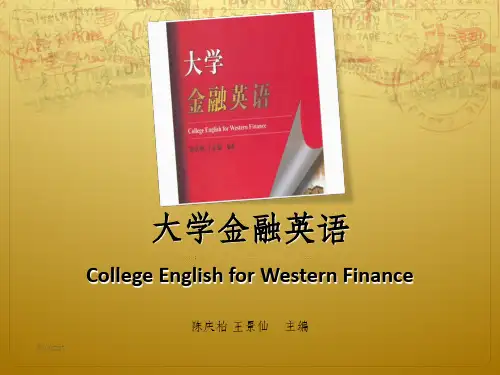
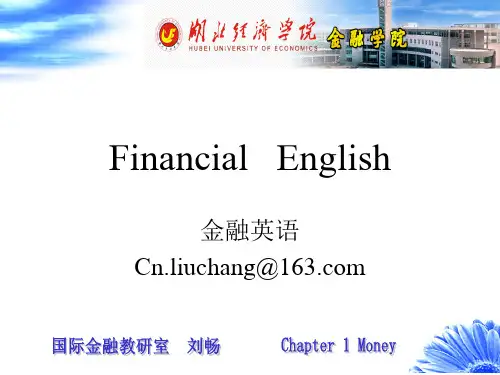
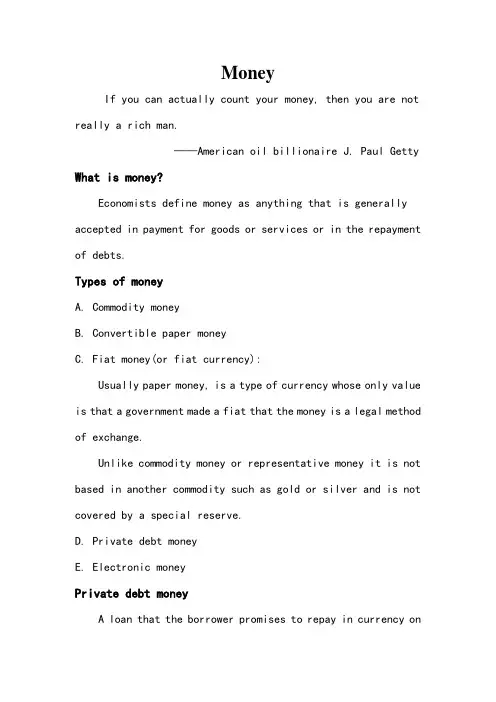
MoneyIf you can actually count your money, then you are not really a rich man.——American oil billionaire J. Paul Getty What is money?Economists define money as anything that is generally accepted in payment for goods or services or in the repayment of debts.Types of moneyA. Commodity moneyB. Convertible paper moneyC. Fiat money(or fiat currency):Usually paper money, is a type of currency whose only value is that a government made a fiat that the money is a legal method of exchange.Unlike commodity money or representative money it is not based in another commodity such as gold or silver and is not covered by a special reserve.D. Private debt moneyE. Electronic moneyPrivate debt moneyA loan that the borrower promises to repay in currency ondemand. E.g. IOU the checkable deposit at commercial banks and other financial institutions.Commercial notes(商业票据):Short-term, unsecured, discounted, and negotiable notes sold by one company to another in order to satisfy immediate cash needs.Include: promissory note (期票,拮据) draft (汇票) check and so on.Electronic money: Electronic Check, Internet Payment System, Credit Card ServiceWhat does money do?A. Medium of ExchangeIn almost all market transactions in our economy, money in the form of currency or checks is a medium of exchange; it is used to pay for goods and services. The use of money as a medium of exchange promotes economic efficiency by eliminating much of the time spent in exchanging goods and services. Terms: Transaction cost, Time value of moneyB. Unit of AccountThe second role of money is to provide a unit of account; that is, it is used to measure value in the economy. We measure the value of goods and services in terms of money, just as we measure weight in terms ofpounds or distance in terms of miles.Note: Fiat money has not only no particular value in use; it doesn't even really have a value in exchange except that which is decreed that it would have.Terms: Good money, Bad moneyC. Store of ValueMoney also functions as a store of value: it is a repository of purchasing power over time. It is an asset. It 's something that we can use to store value away to be retrieved at a later point in time. So we can not consume today, we can hold money instead - and transfer that consumption power to some point in the future.Term: Hard currencyMeasuring Monetary Aggregates1. Measure as “money” only those assets that are most liquid, hence that function best as a medium of exchange.2. Include all financial assets in the measure of money, but weight them in proportion to their liquidity.1. M1 = Most Narrow Measure (Most Liquid)M1 = currency + traveler’s checks + demand deposits + other checkable deposits2. M2 = M1 + Less Liquid AssetsM2 = M1 + small denomination time deposits + savings deposits + money market deposit accounts + money market mutual fund shares3. M3 = M2 + Less Liquid AssetsMoney supplyThe revenue raised through the printing of money. When the government prints money to finance expenditure, it increases the money supply. The increase in the money supply, in turn, causes inflation. Printing money to raise revenue is like imposing an inflation tax.To expand the money supply:The Federal Reserve buys Treasury Bonds and pays for them with new money.To reduce the money supply:The Federal Reserve sells Treasury Bonds and receives the existing dollars and then destroys them.InflationInflation is an increase in the average level of prices, and a price is the rate at which money is exchanged for a good or service.Here is a great illustration of the power of inflation:In 1970, the New York Times cost 15 cents, the median price of a single-family home was $23,400, and the average wage in manufacturing was $3.36 per hour. In 2008, the Times cost $1.50, the price of a home was $183,300, and the average wage was $19.85 per hour.Hyperinflation is defined as inflation that exceeds 50 percent per month, which is just over 1 percent a day. Questions1. Money is not unique as a store of value; any asset, be it money, stocks, bonds, land, houses, art, or jewelry, can be used to store wealth. Many such assets have advantages over money as a store of value: They often pay the owner a higher interest rate than money, experience price appreciation, and deliver services such as providing a roof over one's head. If these assets are a more desirable store of value than money, why do people hold money at all?The answer to this question relates to the important economic concept of liquidity.2. Rank the following assets from most liquid to least liquid:a.Checking account depositsb. Housesc. Currencyd. Washing machinese. Savings depositsf. Common stock3. Why have some economists described money during a hyperinflation as a “hot potato” that is quickly passed from one person to another?4. Was money a better store of value in the United States in the 1950s than it was in the 1970s? Why or why not? In which period would you have been more willing to hold money?5. In Brazil, a country that was undergoing a rapid inflation before 1994, many transactions were conducted in dollars rather than in Reals, the domestic currency. Why? Quiz1. Fiat money is:A. credit card chargesB. CoinsC. not convertible into precious metals.D. checks Answer: C2. Which of these is not a function of money in an economy?A. Store of valueB. Medium of exchangeC. Source of incomeD. Unit of account3. Which of the following is not part of M1?A. checking accountsB. traveler's checksC. savings accountsD. currency Answer:C4. If Mary deposits $100 of her currency in her checking account, then:A. M1 will increase by $100.B. M2 will fall by $100.C. M1 and M2 will not change.D. M2 will increase by $100.Answer:C5. If Mary moves $100 from her savings account to her checking account, then:A. M1 will not change.B. M2 will not change.C. M1 will fall by $100.D. M2 will fall by $100. Answer:B6. Which of the following is not part of M2?A. Small time depositsB. CurrencyC. Institutional money market mutual fundsD. Saving accounts7. Inefficiencies that are created when using checks as money include:A. Checks can transfer funds slowly.B. There are too many bad checks written.C. Checkbooks can be stolen.D. Checks can be written for any amount.Answer:A8. The liquidity of an asset is:A. the ability of an asset to earn interest income.B. the amount of an asset sold at discount or premium.C. the relative ease with which an asset can be converted into a medium of exchange.D. the relative ease with which an asset can be converted into a common stock.Answer:C9. For a commodity to function effectively as money, it mustA. Be widely accepted.B. Be backed by gold or silver.C. Be indestructible.D. Be printed by the government.10. Money supply data is generated by:A. The Department of CommerceB. The Federal Deposit Insurance Corporation (FDIC)C. The Federal Reserve System (the Fed)D. The Treasury DepartmentAnswer:C11. Which of the following correctly shows the evolution of the payments system?A. Commodity money, fiat money, checks, electronic money.B. Commodity money, fiat money, electronic money, checks.C. Commodity money, checks, fiat money, electronic money.D. Fiat money, commodity money, checks, electronic money. Answer:A12.Which of the following is true regarding money's store of value function?A. money does not allow a person to hold purchasing power from the time income is earned until it is spent.B. money is the only store of value available.C. money is the most liquid store of value available.D. money is superior to all other stores of value during periods of inflation.Answer:C13. Which of the following is not a disadvantage of electronic money?A. People are concerned about the privacy and security of e-money transactions.B. E-money transactions cost more than paper check transactions.C. The cost of setting up a system for processing e-money payments is high.D. E-money does not allow people to take advantage of float. Answer:B14. Wealth isA. Generally accepted for the repayment of debtsB. A flow of earnings per unit of timeC. A stock conceptD. The total collection of pieces of property that serve to store valueAnswer:D15. The Fed's measurements of monetary aggregatesA. Are more reliable in the short run than the long run.B. Are revised once a year.C. Does not depend on the definition of money.D. Are more reliable in the long run than the short run. Answer:D(资料素材和资料部分来自网络,供参考。
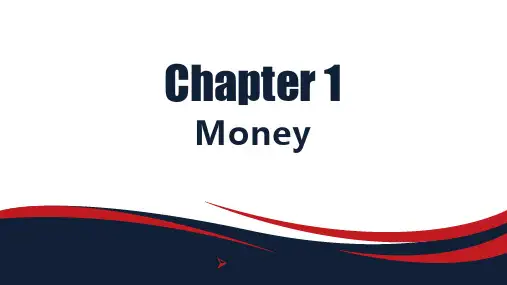

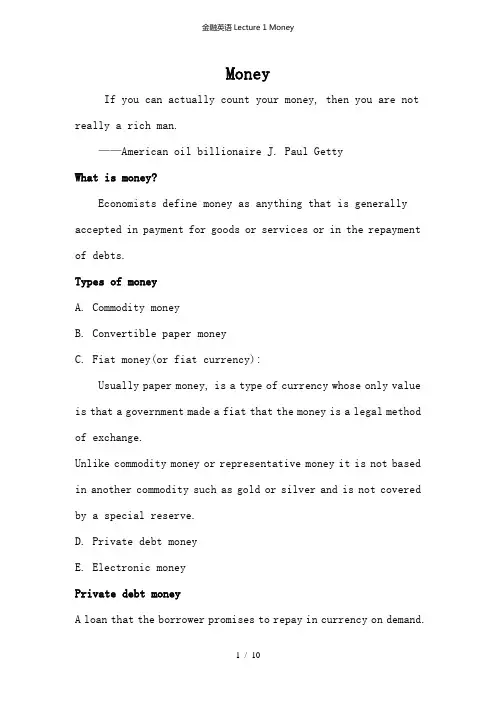
MoneyIf you can actually count your money, then you are not really a rich man.——American oil billionaire J. Paul GettyWhat is money?Economists define money as anything that is generally accepted in payment for goods or services or in the repayment of debts.Types of moneyA. Commodity moneyB. Convertible paper moneyC. Fiat money(or fiat currency):Usually paper money, is a type of currency whose only valueis that a government made a fiat that the money is a legal method of exchange.Unlike commodity money or representative money it is not basedin another commodity such as gold or silver and is not covered by a special reserve.D. Private debt moneyE. Electronic moneyPrivate debt moneyA loan that the borrower promises to repay in currency on demand.E.g. IOU the checkable deposit at commercial banks and other financial institutions.Commercial notes(商业票据):Short-term, unsecured, discounted, and negotiable notes sold by one company to another in order to satisfy immediate cash needs.Include:promissory note (期票,拮据)draft (汇票)check and so on.Electronic money: Electronic Check, Internet Payment System, Credit Card ServiceWhat does money do?A. Medium of ExchangeIn almost all market transactions in our economy, money in the form of currency or checks is a medium of exchange; it is used to pay for goods and services. The use of money as a medium of exchange promotes economic efficiency by eliminating much of the time spent inexchanging goods and services.Terms:Transaction cost, Time value of moneyB. Unit of AccountThe second role of money is to provide a unit of account; that is, it is used to measure value in the economy. We measure the value of goods and services in terms of money, just as we measure weight in terms ofpounds or distance in terms of miles.Note: Fiat money has not only no particular value in use; it doesn't even really have a value in exchange except that which is decreed that it would have.Terms: Good money, Bad moneyC. Store of ValueMoney also functions as a store of value: it is a repository of purchasing power over time. It is an asset. It 's something that we can use to store value away to be retrieved at a later point in time. So we can not consume today, we can hold money instead - and transfer that consumption power to some point in the future.Term: Hard currencyMeasuring Monetary Aggregates1. Measure as “money” only those assets that are most liquid, hence that function best as a medium of exchange.2. Include all financial assets in the measure of money, but weight them in proportion to their liquidity.1. M1 = Most Narrow Measure (Most Liquid)M1 = currency + traveler’s checks + demand deposits + other checkable deposits2. M2 = M1 + Less Liquid AssetsM2 = M1 + small denomination time deposits + savings deposits+ money market deposit accounts + money market mutual fund shares3. M3 = M2 + Less Liquid AssetsMoney supplyThe revenue raised through the printing of money. When the governmentprints money to finance expenditure, it increases the money supply. The increase in the money supply, in turn, causes inflation. Printing money to raise revenue is like imposing an inflation tax.To expand the money supply:The Federal Reserve buys Treasury Bonds and pays for them with new money.To reduce the money supply:The Federal Reserve sells Treasury Bonds and receives the existing dollars and then destroys them.InflationInflation is an increase in the average level of prices, and a price is the rate at which money is exchanged for a good or service.Here is a great illustration of the power of inflation:In 1970, the New York Times cost 15 cents, the median price of a single-family home was $23,400, and the average wage inmanufacturing was $3.36 per hour. In 2008, the Times cost $1.50, the price of a home was $183,300, and the average wage was $19.85 per hour.Hyperinflation is defined as inflation that exceeds 50 percent per month, which is just over 1 percent a day.Questions1.Money is not unique as a store of value; any asset, be it money, stocks, bonds, land, houses, art, or jewelry, can be used to store wealth. Manysuch assets have advantages over money as a store of value: They often pay the owner a higher interest rate than money, experience priceappreciation, and deliver services such as providing a roof over one's head. If these assets are a more desirable store of value than money, why do people hold money at all?The answer to this question relates to the important economic concept of liquidity.2.Rank the following assets from most liquid to least liquid:a.Checking account depositsb. Housesc. Currencyd. Washing machinese. Savings depositsf. Common stock3. Why have some economists described money during a hyperinflation as a “hot potato” that is quickly passed from one person to another?4. Was money a better store of value in the United States in the 1950s than it was in the 1970s? Why or why not? In which period would you have been more willing to hold money?5. In Brazil, a country that was undergoing a rapid inflation before 1994, many transactions were conducted in dollars rather than in Reals, the domestic currency. Why?Quiz1. Fiat money is:A. credit card chargesB. CoinsC. not convertible into precious metals.D. checksAnswer: C2. Which of these is not a function of money in an economy?A. Store of valueB. Medium of exchangeC. Source of incomeD. Unit of accountAnswer:C3. Which of the following is not part of M1?A. checking accountsB. traveler's checksC. savings accountsD. currencyAnswer:C4. If Mary deposits $100 of her currency in her checking account, then:A. M1 will increase by $100.B. M2 will fall by $100.C. M1 and M2 will not change.D. M2 will increase by $100. Answer:C5. If Mary moves $100 from her savings account to her checking account, then:A. M1 will not change.B. M2 will not change.C. M1 will fall by $100.D. M2 will fall by $100.Answer:B6. Which of the following is not part of M2?A. Small time depositsB. CurrencyC. Institutional money market mutual fundsD. Saving accounts Answer:C7. Inefficiencies that are created when using checks as money include:A. Checks can transfer funds slowly.B. There are too many bad checks written.C. Checkbooks can be stolen.D. Checks can be written for any amount.Answer:A8. The liquidity of an asset is:A. the ability of an asset to earn interest income.B. the amount of an asset sold at discount or premium.C. the relative ease with which an asset can be converted intoa medium of exchange.D. the relative ease with which an asset can be converted into a common stock.Answer:C9. For a commodity to function effectively as money, it mustA. Be widely accepted.B. Be backed by gold or silver.C. Be indestructible.D. Be printed by the government. Answer:A10. Money supply data is generated by:A. The Department of CommerceB. The Federal Deposit Insurance Corporation (FDIC)C. The Federal Reserve System (the Fed)D. The Treasury DepartmentAnswer:C11. Which of the following correctly shows the evolution of the payments system?A. Commodity money, fiat money, checks, electronic money.B. Commodity money, fiat money, electronic money, checks.C. Commodity money, checks, fiat money, electronic money.D. Fiat money, commodity money, checks, electronic money. Answer:A12.Which of the following is true regarding money's store ofvalue function?A. money does not allow a person to hold purchasing power from the time income is earned until it is spent.B. money is the only store of value available.C. money is the most liquid store of value available.D. money is superior to all other stores of value during periods of inflation.Answer:C13. Which of the following is not a disadvantage of electronic money?A. People are concerned about the privacy and security ofe-money transactions.B. E-money transactions cost more than paper check transactions.C. The cost of setting up a system for processing e-money payments is high.D. E-money does not allow people to take advantage of float. Answer:B14. Wealth isA. Generally accepted for the repayment of debtsB. A flow of earnings per unit of timeC. A stock conceptD. The total collection of pieces of property that serve to store valueAnswer:D15. The Fed's measurements of monetary aggregatesA. Are more reliable in the short run than the long run.B. Are revised once a year.C. Does not depend on the definition of money.D. Are more reliable in the long run than the short run. Answer:D。
金融英语L e c t u r e1M o n e yMoneyIf you can actually count your money, then you are not really a rich man.——American oil billionaire J. Paul GettyWhat is money?Economists define money as anything that is generally accepted in payment for goods or services or in the repayment of debts.Types of moneyA. Commodity moneyB. Convertible paper moneyC. Fiat money(or fiat currency):Usually paper money, is a type of currency whose only value is that a government made a fiat that the money is a legal method of exchange. Unlike commodity money or representative money it is not based in another commodity such as gold or silver and is not covered by a special reserve.D. Private debt moneyE. Electronic moneyPrivate debt moneyA loan that the borrower promises to repay in currency on demand. E.g. IOU the checkable deposit at commercial banks and other financial institutions.Commercial notes(商业票据):Short-term, unsecured, discounted, and negotiable notes sold by one company to another in order to satisfy immediate cash needs.Include: promissory note (期票,拮据) draft (汇票) check and so on. Electronic money: Electronic Check, Internet Payment System, Credit Card ServiceWhat does money do?A. Medium of ExchangeIn almost all market transactions in our economy, money in the form of currency or checks is a medium of exchange; it is used to pay for goods and services. The use of money as a medium of exchange promotes economic efficiency by eliminating much of the time spent in exchanging goods and services.Terms: Transaction cost, Time value of moneyB. Unit of AccountThe second role of money is to provide a unit of account; that is, it is used to measure value in the economy. We measure the value of goods and services in terms of money, just as we measure weight in terms of pounds or distance in terms of miles.Note: Fiat money has not only no particular value in use; it doesn't even really have a value in exchange except that which is decreed that it would have.Terms: Good money, Bad moneyC. Store of ValueMoney also functions as a store of value: it is a repository of purchasing power over time. It is an asset. It 's something that we can use to store value away to be retrieved at a later point in time. So we can not consume today, we can hold money instead - and transfer that consumption power to some point in the future.Term: Hard currencyMeasuring Monetary Aggregates1. Measure as “money” only those assets that are most liquid, hence that function best as a medium of exchange.2. Include all financial assets in the measure of money, but weight them in proportion to their liquidity.1. M1 = Most Narrow Measure (Most Liquid)M1 = currency + traveler’s checks + demand deposits + other checkable deposits2. M2 = M1 + Less Liquid AssetsM2 = M1 + small denomination time deposits + savings deposits + money market deposit accounts + money market mutual fund shares3. M3 = M2 + Less Liquid AssetsMoney supplyThe revenue raised through the printing of money. When thegovernment prints money to finance expenditure, it increases the money supply. The increase in the money supply, in turn, causes inflation. Printing money to raise revenue is like imposing an inflation tax.To expand the money supply:The Federal Reserve buys Treasury Bonds and pays for them with new money.To reduce the money supply:The Federal Reserve sells Treasury Bonds and receives the existing dollars and then destroys them.InflationInflation is an increase in the average level of prices, and a price is the rate at which money is exchanged for a good or service.Here is a great illustration of the power of inflation:In 1970, the New York Times cost 15 cents, the median price of a single-family home was $23,400, and the average wage in manufacturing was $3.36 per hour. In 2008, the Times cost $1.50, the price of a home was $183,300, and the average wage was $19.85 per hour.Hyperinflation is defined as inflation that exceeds 50 percent per month, which is just over 1 percent a day.Questions1. Money is not unique as a store of value; any asset, be it money, stocks, bonds, land, houses, art, or jewelry, can be used to store wealth.Many such assets have advantages over money as a store of value: They often pay the owner a higher interest rate than money, experience price appreciation, and deliver services such as providing a roof over one's head. If these assets are a more desirable store of value than money, why do people hold money at all?The answer to this question relates to the important economic concept of liquidity.2. Rank the following assets from most liquid to least liquid:a.Checking account depositsb. Housesc. Currencyd. Washing machinese. Savings depositsf. Common stock3. Why have some economists described money during a hyperinflation as a “hot potato” that is quickly passed from one person to another?4. Was money a better store of value in the United States in the 1950s than it was in the 1970s? Why or why not? In which period would you have been more willing to hold money?5. In Brazil, a country that was undergoing a rapid inflation before 1994, many transactions were conducted in dollars rather than in Reals, the domestic currency. Why?Quiz1. Fiat money is:A. credit card chargesB. CoinsC. not convertible into precious metals.D. checksAnswer: C2. Which of these is not a function of money in an economy?A. Store of valueB. Medium of exchangeC. Source of incomeD. Unit of accountAnswer:C3. Which of the following is not part of M1?A. checking accountsB. traveler's checksC. savings accountsD. currencyAnswer:C4. If Mary deposits $100 of her currency in her checking account, then:A. M1 will increase by $100.B. M2 will fall by $100.C. M1 and M2 will not change.D. M2 will increase by $100. Answer:C5. If Mary moves $100 from her savings account to her checking account, then:A. M1 will not change.B. M2 will not change.C. M1 will fall by $100.D. M2 will fall by $100. Answer:B6. Which of the following is not part of M2?A. Small time depositsB. CurrencyC. Institutional money market mutual fundsD. Saving accounts Answer:C7. Inefficiencies that are created when using checks as money include:A. Checks can transfer funds slowly.B. There are too many bad checks written.C. Checkbooks can be stolen.D. Checks can be written for any amount.Answer:A8. The liquidity of an asset is:A. the ability of an asset to earn interest income.B. the amount of an asset sold at discount or premium.C. the relative ease with which an asset can be converted into a medium of exchange.D. the relative ease with which an asset can be converted into a common stock.Answer:C9. For a commodity to function effectively as money, it mustA. Be widely accepted.B. Be backed by gold or silver.C. Be indestructible.D. Be printed by the government. Answer:A10. Money supply data is generated by:A. The Department of CommerceB. The Federal Deposit Insurance Corporation (FDIC)C. The Federal Reserve System (the Fed)D. The Treasury DepartmentAnswer:C11. Which of the following correctly shows the evolution of the payments system?A. Commodity money, fiat money, checks, electronic money.B. Commodity money, fiat money, electronic money, checks.C. Commodity money, checks, fiat money, electronic money.D. Fiat money, commodity money, checks, electronic money. Answer:A12.Which of the following is true regarding money's store of value function?A. money does not allow a person to hold purchasing power from the time income is earned until it is spent.B. money is the only store of value available.C. money is the most liquid store of value available.D. money is superior to all other stores of value during periods of inflation.Answer:C13. Which of the following is not a disadvantage of electronicmoney?A. People are concerned about the privacy and security of e-money transactions.B. E-money transactions cost more than paper check transactions.C. The cost of setting up a system for processing e-money payments is high.D. E-money does not allow people to take advantage of float. Answer:B14. Wealth isA. Generally accepted for the repayment of debtsB. A flow of earnings per unit of timeC. A stock conceptD. The total collection of pieces of property that serve to store value Answer:D15. The Fed's measurements of monetary aggregatesA. Are more reliable in the short run than the long run.B. Are revised once a year.C. Does not depend on the definition of money.D. Are more reliable in the long run than the short run.Answer:D。
[转载]⾦融英语01 ⾦融数字原⽂地址:⾦融英语01 ⾦融数字作者:空⼼菜MaxUnit 1 Money1.1 FiguresAmerican oil billionaire J. Paul Getty has a very famous saying, that is “ If you can actually count your money, then you are not really a rich man.” Well, the sentence is interesting, but actually we must know how to count the money before we get rich, especially in English. So, in today’s class, we would first learn to say English numbers.Let’s talk about the different ways to say 0 in English.Usually, we have the following 5 ways to say 0 in English.They are: OH, ZERO, LOVE, NOUGHT, NIL!We say ohafter a decimal point 6.03 six point oh threein telephone numbers 84 08 32 13 eight four oh eight three two one threein bus numbers No. 708 get the seven oh eightin hotel room numbers Room 308 I'm in room three oh eight.in years 1905 nineteen oh fiveWe say noughtbefore the decimal point 0.201 nought point two oh oneWe say zerofor the number 0 the number zerofor temperature -5~C five degrees below zeroWe say nilin football scores 5-0 Spain won five nil.We say lovein tennis 15- 0 The score is fifteen love.Now say the following:1. The exact figure is 0.002.before the decimal point, read nought;after a decimal point, read oh.Nought point oh oh two.2. Can you get back to me on 010 – 5175 – 0123 ? I'll be here all morning.in telephone numbers, say oh.Oh one oh five one seven five oh one two three3. Can you put that on my bill? I'm in room 804.in hotel room numbers, say oh. Eight oh four4. The temperature in north-east China is very low in winter. Usually, it's 20 degrees below 0!for temperature, say zero.5. Basically, tennis scoring proceeds from 0 to 15 to 30 to 40 to game.love(0), fifteen(15), thirty(30), forty(40), game(胜局)。
MoneyIf you can actually count your money, then you are not really a rich man.——American oil billionaire J. Paul GettyWhat is moneyEconomists define money as anything that is generally accepted in payment for goods or services or in the repayment of debts.Types of moneyA. Commodity moneyB. Convertible paper moneyC. Fiat money(or fiat currency):Usually paper money, is a type of currency whose only value is that a government made a fiat that the money is a legal method of exchange.Unlike commodity money or representative money it is not based in another commodity such as gold or silver and is not covered by a special reserve.D. Private debt moneyE. Electronic moneyPrivate debt moneyA loan that the borrower promises to repay in currency on demand. . IOU the checkable deposit at commercial banks and other financial institutions.Commercial notes(商业票据):Short-term, unsecured, discounted, and negotiable notes sold by one company to another in order to satisfy immediate cash needs.Include: promissory note (期票,拮据) draft (汇票) check and so on. Electronic money: Electronic Check, Internet Payment System, Credit Card ServiceWhat does money doA. Medium of ExchangeIn almost all market transactions in our economy, money in the form of currency or checks is a medium of exchange; it is used to pay for goods and services. The use of money as a medium of exchange promotes economic efficiency by eliminating much of the time spent in exchanging goods and services.Terms: Transaction cost, Time value of moneyB. Unit of AccountThe second role of money is to provide a unit of account; that is, it is used to measure value in the economy. We measure the value of goods and services in terms of money, just as we measure weight in terms of pounds or distance in terms of miles.Note: Fiat money has not only no particular value in use; it doesn't even really have a value in exchange except that which is decreed that it would have.Terms: Good money, Bad moneyC. Store of ValueMoney also functions as a store of value: it is a repository of purchasing power over time. It is an asset. It 's something that we can use to store value away to be retrieved at a later point in time. So we can not consume today, we can hold money instead - and transfer that consumption power to some point in the future.Term: Hard currencyMeasuring Monetary Aggregates1. Measure as “money” only those assets that are most liquid, hence that function best as a medium of exchange.2. Include all financial assets in the measure of money, but weight them in proportion to their liquidity.1. M1 = Most Narrow Measure (Most Liquid)M1 = currency + traveler’s checks + demand deposits + other checkable deposits2. M2 = M1 + Less Liquid AssetsM2 = M1 + small denomination time deposits + savings deposits + money market deposit accounts + money market mutual fund shares 3. M3 = M2 + Less Liquid AssetsMoney supplyThe revenue raised through the printing of money. When thegovernment prints money to finance expenditure, it increases the money supply. The increase in the money supply, in turn, causes inflation. Printing money to raise revenue is like imposing an inflation tax.To expand the money supply:The Federal Reserve buys Treasury Bonds and pays for them with new money.To reduce the money supply:The Federal Reserve sells Treasury Bonds and receives the existing dollars and then destroys them.InflationInflation is an increase in the average level of prices, and a price is the rate at which money is exchanged for a good or service.Here is a great illustration of the power of inflation:In 1970, the New York Times cost 15 cents, the median price of a single-family home was $23,400, and the average wage in manufacturing was $ per hour. In 2008, the Times cost $, the price of a home was $183,300, and the average wage was $ per hour.Hyperinflation is defined as inflation that exceeds 50 percent per month, which is just over 1 percent a day.Questions1. Money is not unique as a store of value; any asset, be it money, stocks, bonds, land, houses, art, or jewelry, can be used to store wealth.Many such assets have advantages over money as a store of value: They often pay the owner a higher interest rate than money, experience price appreciation, and deliver services such as providing a roof over one's head. If these assets are a more desirable store of value than money, why do people hold money at allThe answer to this question relates to the important economic concept of liquidity.2. Rank the following assets from most liquid to least liquid:a.Checking account depositsb. Housesc. Currencyd. Washing machinese. Savings depositsf. Common stock3. Why have some economists described money during ah yperinflation as a “hot potato” that is quickly passed from one person to another4. Was money a better store of value in the United States in the 1950s than it was in the 1970s Why or why not In which period would you have been more willing to hold money5. In Brazil, a country that was undergoing a rapid inflation before 1994, many transactions were conducted in dollars rather than in Reals, the domestic currency. WhyQuiz1. Fiat money is:A. credit card chargesB. CoinsC. not convertible into precious metals.D. checksAnswer: C2. Which of these is not a function of money in an economyA. Store of valueB. Medium of exchangeC. Source of incomeD. Unit of account Answer:C3. Which of the following is not part of M1A. checking accountsB. traveler's checksC. savings accountsD. currency Answer:C4. If Mary deposits $100 of her currency in her checking account, then:A. M1 will increase by $100.B. M2 will fall by $100.C. M1 and M2 will not change.D. M2 will increase by $100. Answer:C5. If Mary moves $100 from her savings account to her checking account, then:A. M1 will not change.B. M2 will not change.C. M1 will fall by $100.D. M2 will fall by $100. Answer:B6. Which of the following is not part of M2A. Small time depositsB. CurrencyC. Institutional money market mutual fundsD. Saving accounts Answer:C7. Inefficiencies that are created when using checks as money include:A. Checks can transfer funds slowly.B. There are too many bad checks written.C. Checkbooks can be stolen.D. Checks can be written for any amount.Answer:A8. The liquidity of an asset is:A. the ability of an asset to earn interest income.B. the amount of an asset sold at discount or premium.C. the relative ease with which an asset can be converted into a medium of exchange.D. the relative ease with which an asset can be converted into a common stock.Answer:C9. For a commodity to function effectively as money, it mustA. Be widely accepted.B. Be backed by gold or silver.C. Be indestructible.D. Be printed by the government. Answer:A10. Money supply data is generated by:A. The Department of CommerceB. The Federal Deposit Insurance Corporation (FDIC)C. The Federal Reserve System (the Fed)D. The Treasury DepartmentAnswer:C11. Which of the following correctly shows the evolution of the payments systemA. Commodity money, fiat money, checks, electronic money.B. Commodity money, fiat money, electronic money, checks.C. Commodity money, checks, fiat money, electronic money.D. Fiat money, commodity money, checks, electronic money. Answer:A12.Which of the following is true regarding money's store of value functionA. money does not allow a person to hold purchasing power from the time income is earned until it is spent.B. money is the only store of value available.C. money is the most liquid store of value available.D. money is superior to all other stores of value during periods of inflation.Answer:C13. Which of the following is not a disadvantage of electronicmoneyA. People are concerned about the privacy and security of e-money transactions.B. E-money transactions cost more than paper check transactions.C. The cost of setting up a system for processing e-money payments is high.D. E-money does not allow people to take advantage of float. Answer:B14. Wealth isA. Generally accepted for the repayment of debtsB. A flow of earnings per unit of timeC. A stock conceptD. The total collection of pieces of property that serve to store value Answer:D15. The Fed's measurements of monetary aggregatesA. Are more reliable in the short run than the long run.B. Are revised once a year.C. Does not depend on the definition of money.D. Are more reliable in the long run than the short run.Answer:D。